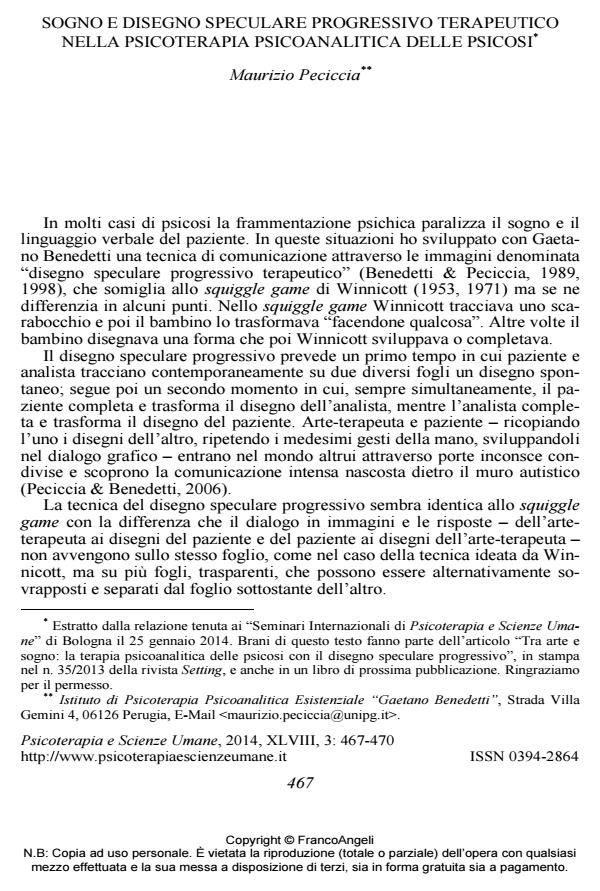Dream and progressive mirror drawing in the psychoanalytic psychotherapy of psychoses
Journal title PSICOTERAPIA E SCIENZE UMANE
Author/s Maurizio Peciccia
Publishing Year 2014 Issue 2014/3 Language Italian
Pages 4 P. 467-470 File size 27 KB
DOI 10.3280/PU2014-003006
DOI is like a bar code for intellectual property: to have more infomation
click here
Below, you can see the article first page
If you want to buy this article in PDF format, you can do it, following the instructions to buy download credits

FrancoAngeli is member of Publishers International Linking Association, Inc (PILA), a not-for-profit association which run the CrossRef service enabling links to and from online scholarly content.
The technique of "progressive mirror drawing" for the psychodynamic therapy of psychoses, developed by Gaetano Benedetti (1920-2013) and Maurizio Peciccia, is described. In this technique, patient and therapist simultaneously draw a picture on two different paper sheets, and subsequently both of them complete and transform the drawing of the other. The patient and the art-therapist - by repeating the same hand movements within this graphic dialogue - enter into the world of the other through shared unconscious communications and, like in a dream, open themselves to a previously hidden meanings. This technique differs from Winnicott’s "squiggle game", in which the therapist draws a squiggle that the child subsequently transforms into something else, while other times the child draws a picture that eventually the therapist elaborates and completes.
Keywords: Drawing, progressive mirror drawing, psychodynamic therapy of psychoses, squiggle game, art-therapy
- Benedetti G. (1980). Alienazione e personazione nella psicoterapia della malattia mentale. Torino: Einaudi.
- Benedetti G. (1991). Paziente e terapeuta nell'esperienza psicotica. Torino: Bollati Boringhieri.
- Benedetti G. (1992). Psychotherapie als existentielle Herausforderung. Goettingen: Vandenhoeck Ruprecht (trad. it.: La psicoterapia come sfida esistenziale. Milano: Raffaello Cortina, 1997).
- Benedetti G. & Peciccia M. (1989). Das Katathyme Spiegelbild. In: Bartl G. & Pesendorfer F., editors, Strukturbildung im therapeutischen Prozess. Wien: Literas-Universitätsverlag, 1989, pp. 125-139.
- Benedetti G. & Peciccia M. (1995). Sogno, inconscio, psicosi. Chieti: Métis.
- Benedetti G. & Peciccia M. (1998). The ego structure and the self-identity of the schizophrenic human and the task of psychoanalysis. International Forum of Psychoanalysis, 7, 3: 169-174. DOI: 10.1080/080370698436844
- Peciccia M. & Benedetti G. (2006). L’immagine nella psicoterapia analitica delle psicosi. In: Malinconico A. & Peciccia M. (2006). Al di là della parola. Vie nuove per la terapia analitica delle psicosi. Roma: Magi, 2006, pp. 69-131.
- Racamier P.-C. (1976). Rêve et psychose: rêve ou psychose. Revue Française de Psychanalyse, XL, 1: 173-193.
- Winnicott D.W. (1953). Symptom tolerance in paediatrics. In: Collected Papers. Through Pediatrics to Psychoanalysis [1931-1956]. London: Tavistock, 1958, pp. 101-117 (trad. it.: Tolleranza del sintomo in pediatria. Esposizione di un caso. In: Dalla pediatria alla psicoanalisi. Scritti scelti. Firenze: Martinelli, 1975, cap. IX, pp. 124-142).
- Winnicott D.W. (1971). Therapeutic consultations in child psychiatry. The International Psycho-Analytical Library, 87: 1-398. London: The Hogarth Press and the Institute of Psycho-Analysis.
- From the “squiggle game” to “games of reciprocity” towards a creative co-construction of a space for working with adolescents Alberto Stefana, Alessio Gamba, in The International Journal of Psychoanalysis /2018 pp.355
DOI: 10.1080/00207578.2017.1416270
Maurizio Peciccia, Sogno e disegno speculare progressivo terapeutico nella psicoterapia psicoanalitica delle psicosi in "PSICOTERAPIA E SCIENZE UMANE" 3/2014, pp 467-470, DOI: 10.3280/PU2014-003006